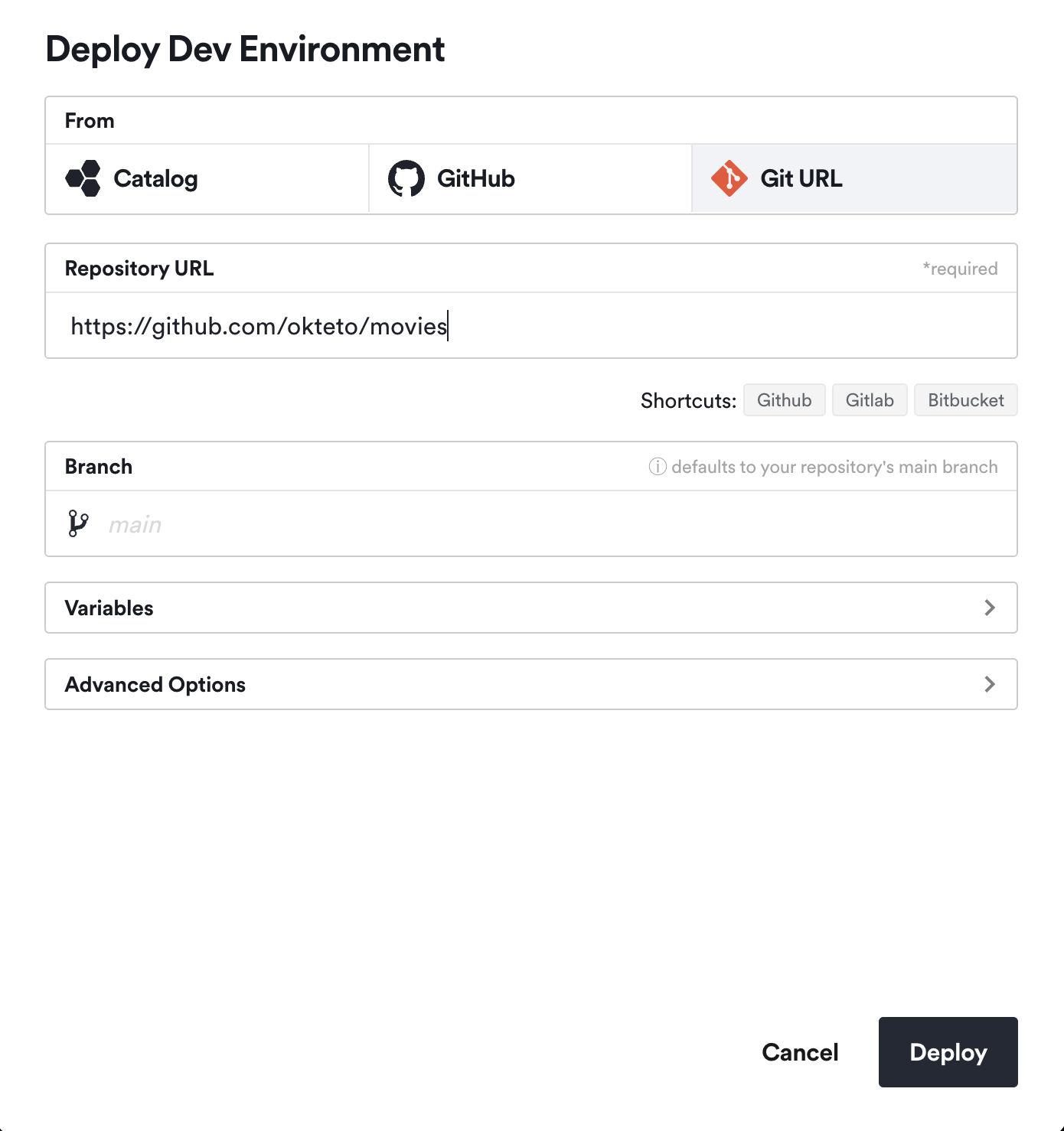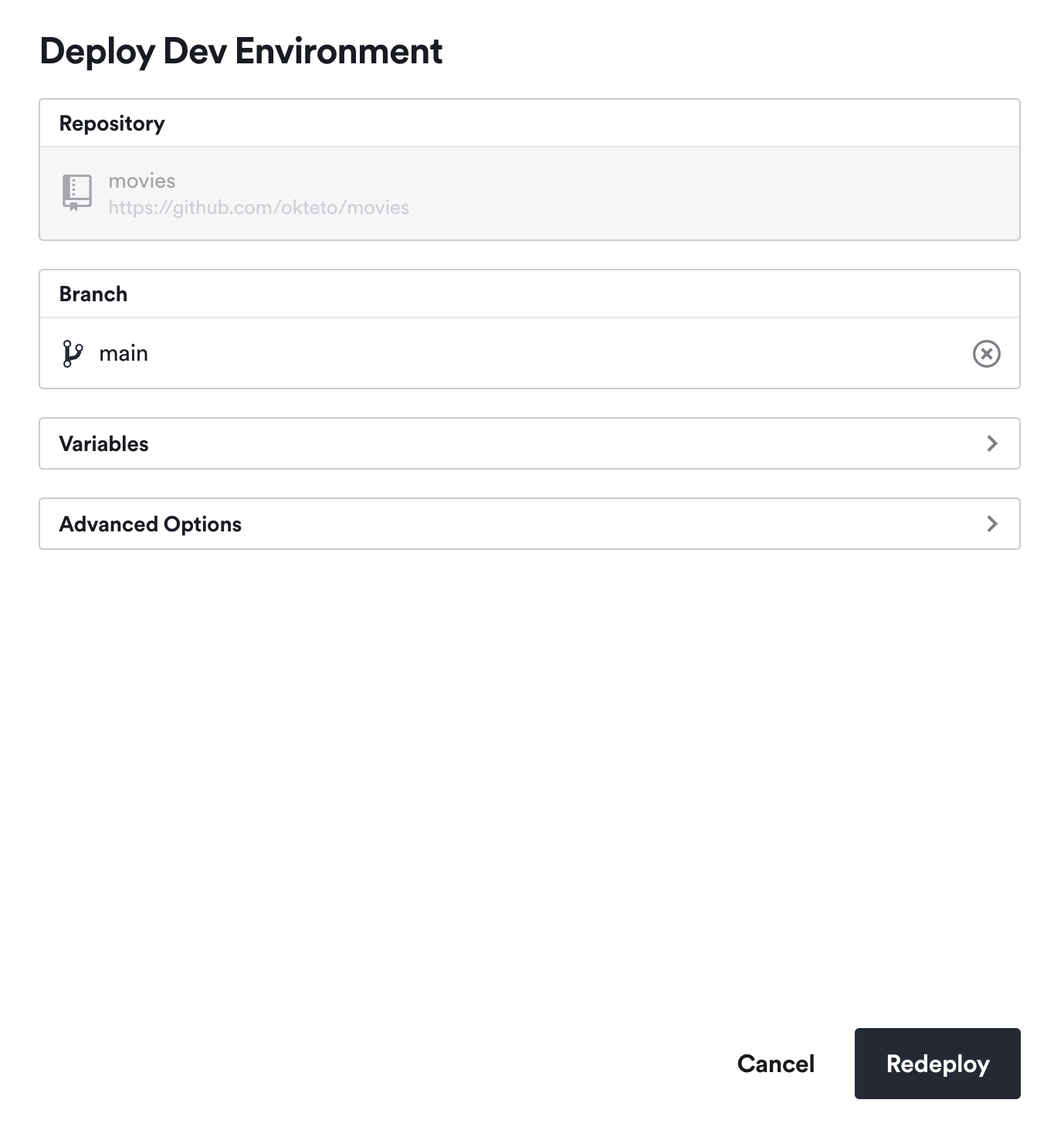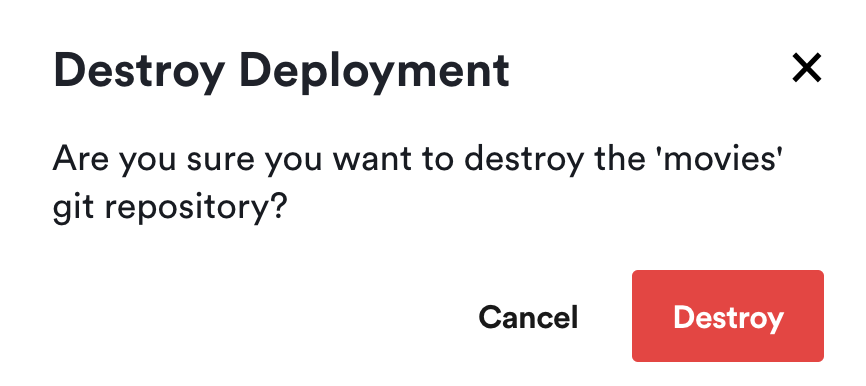Deploy your Development Environments from your Git Repositories
Prerequisites
Please make sure to configure your Git repositories with the appropriate manifests before using them to deploy Dev Environments.
Deploy
Log in to your Okteto instance (e.g. https://okteto.example.com), and click on the Deploy Dev Environment button on the top left.
A dialog will open asking for a Git repository to deploy. Make sure that "Git URL" is selected as the source.
Type the URL for the Movies App repo (https://github.com/okteto/movies), pick a branch, and click Deploy:

When you deploy a dev environment using a Git repository, Okteto will analyze your repo and automatically deploy it running okteto deploy --build.
In the example above, Okteto will install a Helm chart with the Movies App demo.
Check the Okteto Manifest to learn more about how to configure your development environment deployment with an okteto.yaml file.
As soon as your development environment is deployed, you'll see its state in the UI. The UI will be automatically updated as the different components are created.
Your development environment will be ready to go once it reaches the Success state.

Redeploy
Click the Redeploy button on the right of your development environment.
A dialog will open where you can modify the branch to redeploy:

Click Deploy and your development environment will be updated with the source code of the given branch.
Destroy
You can also destroy your development environment with a single click.
Go back to the extended menu of your development environment and click the Destroy button. A confirmation dialog will pop up. Click on Destroy and your development environment and all of the resources created for it will be gone:

You won't be able to recover resources after the development environment has been destroyed, so back up any sensitive data before running this action.
Variables
When you deploy from Git, you can add Variables that will be available as environment variables during the deployment of your development environment.
Adding a Develop on Okteto Button
The Develop on Okteto button is a shortcut to deploy your development environments with a single click.
The button is designed to be used in GitHub README files, documentation sites, or pretty much anywhere that renders an HTML file. Use this instead of writing a never-ending list of manual steps on how to deploy your development environments.
Here's an example button that shows you how to deploy the Movies App on an Okteto instance:
Adding the Develop on Okteto button
There are two ways of referencing the source code repository:
- Resolve it implicitly. This is useful in GitHub
README.files. If you don't specify the repository, Okteto will infer it using thereferrerheader. This only works on public repositories hosted in https://github.com. - Using the
repositoryandbranchparameters. This is useful for buttons hosted outside of https://github.com, in blog posts, or documentation.
Using an implicit repository
If you're embedding the button in a public GitHub repository's README file, Okteto will automatically infer the repository and the branch using the referrer header when someone clicks on the button.
Here's an example:
[](https://okteto.example.com/deploy)
And here's the equivalent content as HTML if you prefer that:
<a href="https://okteto.example.com/deploy">
<img src="https://okteto.com/develop-okteto.svg" alt="Develop on Okteto" />
</a>
A develop-okteto.png is also available.
Adding explicit parameters
Use the following Markdown snippet as a template, changing the repository and branch query parameters to match your repository. The branch query parameter is optional.
[](https://okteto.example.com/deploy?repository=https://github.com/okteto/movies&branch=main)
And here's the equivalent content as HTML if you prefer that:
<a
href="https://okteto.example.com/deploy?repository=https://github.com/okteto/movies&branch=main"
>
<img src="https://okteto.com/develop-okteto.svg" alt="Develop on Okteto" />
</a>
Parameters
You can parametrize your development environment deployment using the following parameters:
repository: The repository to be deployed. If it's not present, Okteto will automatically infer it using the referrer header, if available.branch: The repository branch to be deployed. If not included, it will use the default branch of the repository.vars: It allows you to specify a list of variables that will be available as environment variables during the deployment. It is optional. .e.gvars=[{"name":"THEME","value":"dark"},{"name":"LANG","value":"en"}]. This would generate 2 environment variables avaible on your deployment:THEME=darkandLANG=en. It has to be URL encoded.filename: The location of the Okteto Manifest relative to the root of the repository.